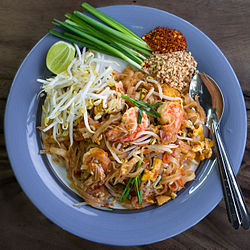Pad thai
 Pad Thai from a street stall in Chiang Mai | |
| Alternative names | Phat Thai |
|---|---|
| Type | Rice noodles |
| Place of origin | Thailand |
| Associated cuisine | Thai |
| Serving temperature | Hot |
| Main ingredients | Dried rice noodles, eggs, tofu, tamarind pulp, fish sauce, dried or fresh shrimp, garlic or shallots, red chili pepper, palm sugar, lime, peanuts |
Pad Thai, phat Thai or phad Thai (Thai: ผัดไทย, RTGS: phat thai, ISO p̄hạdịthy, pronounced [pʰàt tʰāj] ⓘ, "fried Thai style") is a stir-fried rice noodle dish commonly served as a street food and at casual local eateries in Thailand. It is made with soaked dried rice noodles, which are stir-fried with eggs and chopped firm tofu, and flavored with tamarind pulp, fish sauce ([nampla น้ำปลา] Error: {{Lang}}: text has italic markup (help)), dried shrimp, garlic or shallots, red chili pepper and palm sugar, and served with lime wedges and often chopped roast peanuts.[1] It may also contain other vegetables like bean sprouts, garlic chives, coriander leaves, pickled radishes or turnips ([hua chaipo หัวไชโป๊] Error: {{Lang}}: text has italic markup (help)), and raw banana flowers. It may also contain fresh shrimp, crab, squid, chicken or other proteins. Vegetarian versions may substitute soy sauce for the fish sauce and omit the shrimp.
History
A dish of stir-fried rice noodles is thought by some to have been introduced to Ayutthaya during the time of the Ayutthaya Kingdom by Vietnamese traders,[2] and subsequently altered to reflect Thai flavor profiles.[3][citation needed] Others believe that the dish is of Chinese origin,[4] and the etymology of the dish's name suggests it.[5][6][7]
Plaek Phibunsongkhram promoted pad Thai in his campaign to establish Thai nationalism.[8][9] Thailand was a main exporter of rice, and the government hoped to increase the amount available for export.[10] As prime minister of Thailand between 1938 and 1944 and from 1948 to 1957, Phibun hoped to Westernize the country. In 1939, he supported the change of name of the country from Siam to Thailand. At the time, wheat noodles were very popular in Thailand, but Plaek Phibunsongkhram sought to eliminate Chinese influence. His government promoted rice noodles and helped to establish the identity of Thailand. As a result, a new noodle named sen chan was created.
Pad Thai was made popular in Thailand during World War II. Pad Thai has since become one of Thailand's national dishes.[11] Today, some food vendors add pork-chops to enhance the taste (although the original recipe did not contain pork because of the government perception that pork was a Chinese meat). Some food vendors still use the original recipe. It is a fast, delicious and nutritious dish, and has become popular in many countries around the world.[citation needed]
Pop culture
- Pad Thai is listed at number 5 on World's 50 most delicious foods readers' poll compiled by CNN Go in 2011.[12]
- The Thai film Jao saao Pad Thai uses pad Thai as a plot device as the protagonist claims she will marry whoever eats her pad Thai for 100 days in a row.[13]
- In 2008, in an episode of Throwdown! with Bobby Flay, Bobby Flay was defeated by Chef Nongkran Daks at her restaurant, Thai Basil, in Chantilly, Virginia.[14]
See also
References
- ^ "Pad Thai - ผัดไทยกุ้งสด". thaitable.com. Retrieved 2013-07-28.
- ^ "History discovered in a staple dish". Bangkok Post. 2014-02-16. Retrieved 2015-02-08.
- ^ "Pad Thai". Ec-padthai.com. Archived from the original on February 18, 2013. Retrieved 2013-02-23.
{{cite web}}: Unknown parameter|deadurl=ignored (|url-status=suggested) (help) - ^ "The Truth About Pad Thai". BBC. 2015-04-28.
- ^ Ferdman, Roberto A. "The strange and potentially stolen origins of pad Thai". Quartz. Atlantic Media Company. Retrieved 15 April 2014.
- ^ "Pad Thai". Kasma Loha-unchit, Thai Food and Travel Blog. 2009-11-26. Retrieved 2015-02-08.
- ^ "Finding Pad Thai". Gastronomica. 2009. Retrieved 2015-10-29.
- ^ "What is Thai Cuisine?" (PDF). Scholarbank.nus.edu.sg. 2010-04-12. Retrieved 2013-02-23.
- ^ Mayyasi, Alex. "The Invention of Pad Thai". Priceonomics. Retrieved 29 October 2015.
- ^ "Madam Mam Articles". Madammam.com. Retrieved 2013-02-23.
- ^ SEARCH (2011-08-15). "Thai National Foods". Ifood.tv. Retrieved 2013-02-23.
- ^ CNN Go Your pick: World's 50 most delicious foods 7 September 2011. Retrieved 2011-10-11
- ^ Jao saao Pad Thai (2004) - Plot Summary
- ^ "Pad Thai : Throwdown With Bobby Flay". Food Network. 2009-11-16. Retrieved 2013-02-23.

